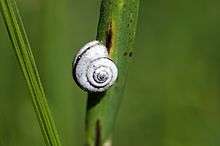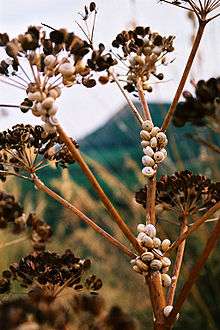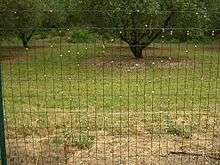Cernuella virgata
| Cernuella virgata | |
|---|---|
 | |
| Cernuella virgata aestivating on a plant's stem in Spain. | |
| Scientific classification | |
| Kingdom: | Animalia |
| Phylum: | Mollusca |
| Class: | Gastropoda |
| (unranked): | clade Heterobranchia clade Euthyneura clade Panpulmonata clade Eupulmonata clade Stylommatophora informal group Sigmurethra |
| Superfamily: | Helicoidea |
| Family: | Hygromiidae |
| Subfamily: | Hygromiinae |
| Tribe: | Hygromiini |
| Genus: | Cernuella |
| Subgenus: | Cernuella |
| Species: | C. virgata |
| Binomial name | |
| Cernuella virgata (Da Costa, 1778)[1] | |
| Synonyms | |
|
Helicella virgata | |
Cernuella virgata, also known as Helicella virgata, common name, the "vineyard snail", is a species of small, air-breathing land snail, a pulmonate gastropod mollusk in the family Hygromiidae, the hairy snails and their allies.
This species of snail makes and uses love darts.
Shell description
The shell is from 6 to 19 mm in height and 8 to 25 mm in width.
The coloration of the shell is quite variable, but there is often a creamy-white background, with a variable number of pale to darker brown markings. Some shells are banded at the periphery and on the underside.
Technical Description
For terms see gastropod shell
The 15 x 12–23 mm. shell has 4.5-5.5 convex whorls.The last whorl is initially angulated or rounded. The aperture is rounded with a whitish or reddish lip inside and margin is not reflected, The umbilicus is always open, 1/10-1/6 of shell diameterand sometimes slightly excentric. The cloour of the periostracum is whitish or yellowish, sometimes with red hue and usually with two brown colour bands on the upper side and 3-4 narrower bands on the lower side, initially finely ribbed, weakly striated at lower whorls.[2]
Distribution

This snail is endemic to Mediterranean and Western Europe, including the British Isles.[3] This species has been recovered from the Roman occupation of Volubilis, an archaeological site in present-day Morocco.[4]
Cernuella virgata is an invasive species and an agricultural pest in parts of Australia, where it arrived around 1920. In Australia it is known as the "common white snail".[5][6]
Another land snail which is present as an invasive in Australia, and which is sometimes confused with Cernuella virgata is the species Theba pisana. It is somewhat similar in appearance, and lives under similar circumstances. Theba pisana is however a larger species with a more inflated shell, lower spire and a nearly covered umbilicus.
Comparison of shells of Cernuella virgata and Theba pisana:
-

Cernuella virgata, showing the "open" umbilicus
-

Theba pisana with nearly "closed" umbilicus
-
Five views of a shell
Behavior and human relevance
This species aestivates after climbing to the top of vegetation (or fences). This habit is problematic for farmers engaged in crop harvesting, because numerous snails are collected along with the crop.
Life cycle
The size of the egg is 1.5 mm.[7]
Parasites
Cernuella virgata is as intermediate host for the terrestrial trematode parasite Brachylaima cribbi.[8]
Gastronomy
Cernuella virgata, with Theba pisana, is consumed in Spain as a "tapa" in the bars, especially in Andalusia, where snails are known as "Chichos" snails.[9]
See also
References
- ↑ Da Costa, E. M. 1778. Historia naturalis testaceorum Britanniæ, or, the British conchology; containing the descriptions and other particulars of natural history of the shells of Great Britain and Ireland: illustrated with figures. - Historia naturalis testaceorum Britanniæ, ou, la conchologie Britannique; contenant les descriptions & autres particularités d'histoire naturelle des coquilles de la Grande Bretagne & de l'Irlande: avec figures en taille douce. En anglois & françois. - pp. i-xii [= 1-12], 1-254, i-vii [= 1-7], [1],, Pl. I-XVII [= 1-17]. London. (Millan, White, Emsley & Robson). (in English and in French).
- ↑ Animalbase (Welter-Schultes)
- ↑ Kerney M.P. & Cameron R. A. D., 1979. A field guide to the land snails of Britain and northwestern Europe. Collins, London, ISBN 0-00-219676-X.
- ↑ C. Michael Hogan (2007) Volubilis, The Megalithic Portal, ed. A. Burnham
- ↑ Barker G. M. 2004. Natural Enemies of Terrestrial Molluscs, CABI Publishing, 644 pp., ISBN 0-85199-319-2
- ↑ Common white snail or Mediterranean white snail, Quarantine Tasmania fact sheet. Tasmania's Department of Primary Industries and Water.
- ↑ Heller J.: Life History Strategies. in Barker G. M. (ed.): The biology of terrestrial molluscs. CABI Publishing, Oxon, UK, 2001, ISBN 0-85199-318-4. 1-146, cited page: 428.
- ↑ Butcher A. R. & Grove D. I.: Seasonal variation in rates of sporocyst and metacercarial infection by Brachylaima cribbi in helicid and hygromiid land snails on the Yorke Peninsula, South Australia. - Australian Journal of Zoology, 2006, 53(6): 375–382.
- ↑ Helix de Córdoba
External links
- Cernuella virgata at Animalbase taxonomy,short description, distribution, biology,status (threats), images
- Cernuella virgata images at Encyclopedia of Life
- Fauna Europaea Search Distribution
